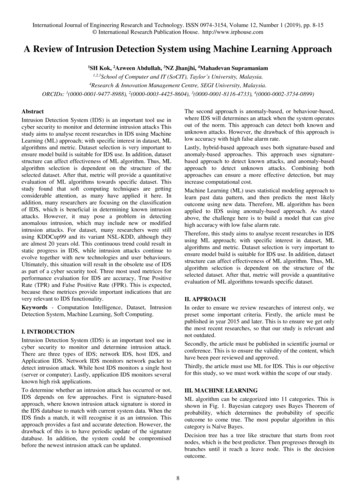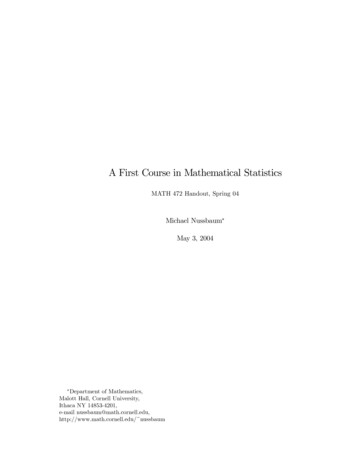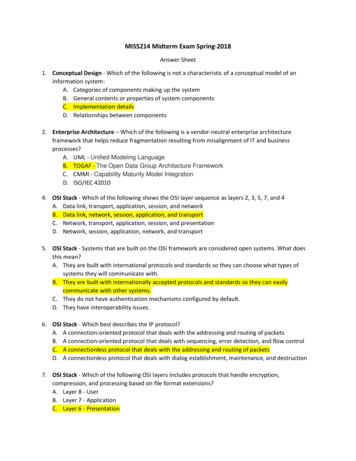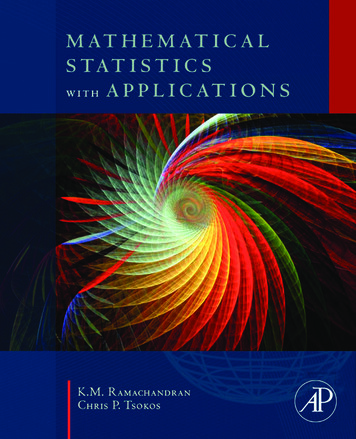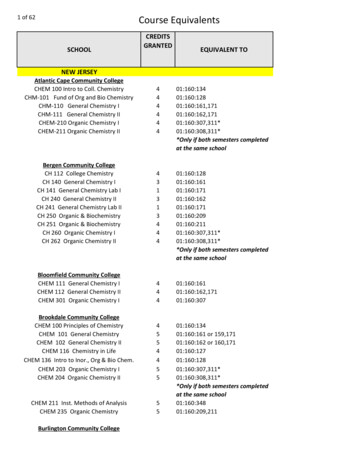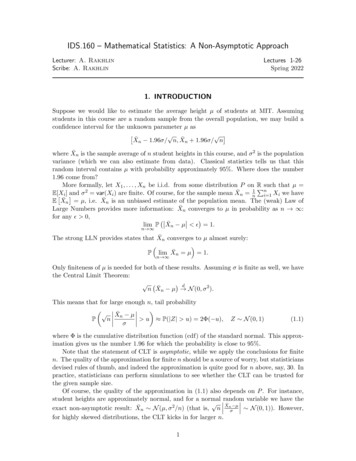
Transcription
IDS.160 – Mathematical Statistics: A Non-Asymptotic ApproachLecturer: A. RakhlinScribe: A. RakhlinLectures 1-26Spring 20221. INTRODUCTIONSuppose we would like to estimate the average height µ of students at MIT. Assumingstudents in this course are a random sample from the overall population, we may build aconfidence interval for the unknown parameter µ as X̄n 1.96σ/ n, X̄n 1.96σ/ nwhere X̄n is the sample average of n student heights in this course, and σ 2 is the populationvariance (which we can also estimate from data). Classical statistics tells us that thisrandom interval contains µ with probability approximately 95%. Where does the number1.96 come from?More formally, let X1 , . . . , Xn be i.i.d. from some distribution P on RPnsuch that µ 2 var(X ) are finite. Of course, for the sample mean X̄ 1E[X]andσini 1 Xi we haven i E X̄n µ, i.e. X̄n is an unbiased estimate of the population mean. The (weak) Law ofLarge Numbers provides more information: X̄n converges to µ in probability as n :for any 0, lim P X̄n µ 1.n The strong LLN provides states that X̄n converges to µ almost surely: P lim X̄n µ 1.n Only finiteness of µ is needed for both of these results. Assuming σ is finite as well, we havethe Central Limit Theorem: d n X̄n µ N (0, σ 2 ).This means that for large enough n, tail probability X̄n µn u P( Z u) 2Φ( u),PσZ N (0, 1)(1.1)where Φ is the cumulative distribution function (cdf) of the standard normal. This approximation gives us the number 1.96 for which the probability is close to 95%.Note that the statement of CLT is asymptotic, while we apply the conclusions for finiten. The quality of the approximation for finite n should be a source of worry, but statisticiansdevised rules of thumb, and indeed the approximation is quite good for n above, say, 30. Inpractice, statisticians can perform simulations to see whether the CLT can be trusted forthe given sample size.Of course, the quality of the approximation in (1.1) also depends on P . For instance,student heights are approximately normal, and for a normal random variable we have the exact non-asymptotic result: X̄n N (µ, σ 2 /n) (that is, n X̄nσ µ N (0, 1)). However,for highly skewed distributions, the CLT kicks in for larger n.1
This course is centered on non-asymptotic results. In the context of one-dimensionalmean estimation, we will show in the next lecture that, under appropriate assumptions onP, X̄n µP u 2 exp cu2 ,(1.2)nσwhich holds for any n. Here c is some constant that depends on properties of P and maybe somewhat larger than the one suggested by the limiting distribution. Thus, confidenceintervals derived with such non-asymptotic methods may be somewhat wider, yet they holdfor any n. On the downside, we will have to place stronger assumptions on the distributionthan those required by the CLT.One may argue that in modern applications, n is very often large. However, it is alsotrue that many applications of interest are characterized by high dimensionality of data, orcomplex structure. In such problems, as we see below, asymptotic analysis based on n may not suffice.1.1 Covariance estimationi.i.d.dTSuppose X1 , . . . , XPn , X P on R and E[X] 0. Let Σ E[XX ] be the covariancen1Tb matrix, and Σi 1 Xi Xi sample covariance. Clearly, sample covariance is an unbiasednestimate of Σ. What can we say about the quality of such an estimate? For any pairb i,j converges to Σi,j in probability by the LLN (it’s ani, j 1, . . . , d, it still holds that Σaverage of independent products). Similarly, db i,j Σi,j ) N (0, var(X1,i X1,j )),n(Σb is a consistent estimator ofunder the appropriate moment assumptions. In particular, ΣΣ. This positive result, however, disregards the role of dimension d. In many problemsof interest, dimensionality of the data may be of the same or similar order as the numberof datapoints (e.g. genomics applications). Is it then reasonable to disregard the role of dwhile sending n to infinity?There are two approaches to address the issue of high dimensionality: Consider an asymptotic setting where both n and d increase. Develop a non-asymptotic result that exhibits explicit dependence on d and n.We start with the first approach. To make sense of this setting, consider a sequence ofproblems where both n and d are increasing at a constant aspect ratio α d/n (0, 1].Such a scaling is called high-dimensional asymptotics.In high-dimensional analysis we are often interested in convergence in the operator normkAk supx6 0kAxk2.kxk2Let’s see if such convergence holds in the high-dimensional asymptotics regime. For simplicb . . . λd (Σ)b 0 beity, take Σ I, assume that coordinates of X are i.i.d., and let λ1 (Σ)bbthe eigenvalues of Σ. If Σ converges in spectral norm to Σ I, the histogram of (random)eigenvalues should be concentratedat 1. In particular, we would expect the empirical disn 1 Pdtribution of eigenvalues d i 1 δλi δ1 . This indeed happens when d is kept fixed and2
n taken to infinity. Yet in the proportional high-dimensional regime, the limiting distribution of the empirical spectrum is not δ1 but follows the Marčhenko-Pastur law [23]. This distribution has density supported on [λ , λ ] where λ (1 α)2 , λ (1 α)2 .The density has the formp(λ t)(t λ )p(t) tfor α (0, 1] (and for α 1, there is an atom at 0). We see that when d, n both growb does not converge to Σ in the desired sense. To conclude, if we had,proportionally, Σsay, genomic data with d 20K and n 30K, we should probably not trust the samplecovariance matrix as an estimate of the true covariance matrix, even though the data sizeappears to be large.Analogously to the development in the previous section, we can contrast the asymptoticapproach with non-asymptotic tail bounds that hold for all n, d. In particular, we will showthat, under additional assumptions, the largest eigenvalue of the sample covariance matrixsatisfies 2 p b 1 d/n uP λ1 (Σ) exp nu2 /2 , u 0(1.3)1.2 Hypothesis testing in high dimensionSuppose X has distribution either P1 N (µ1 , Σ) or P2 N (µ2 , Σ). In this case, theNeyman-Pearson lemma says that the most powerful hypothesis test (P1 vs P2 ) is to comparethe likelihood-ratio to a fixed threshold τ :dP1 (x) τ.logdP2 (x)Using the form of the Gaussian multivariate density yields a simple statistic for testing:1Ψ(x) hµ1 µ2 , Σ 1 (x (µ1 µ2 )/2)i.If Type I and II errors are weighted equally,11P1 (Ψ(x) 0) P2 (Ψ(x) 0) Φ( /2)(1.4)22Rγ2where kµ1 µ2 k2 and Φ(γ) 12π e t /2 dt.P 1P 2If µ1 and µ2 are unknown, we may estimate them by X̄1 n11 ni 1Xi , X̄2 n11 ni 1Xi0on two independent samples from the two respective distributions. Let us assume forsimplicity that Σ I. The plug-in rule is then based on the statisticbΨ(x) hX̄1 X̄2 , x (X̄1 X̄2 )/2i.Kolmogorov in 1970’s studied the high-dimensional asymptotics of this problem whereb instead convergesn1 , n2 , d while d/n1 α, d/n2 α. He showed that the error of Ψin probability to 2Φ .2 2 2αNote that when α 0, the result recovers (1.4). When the asymptotics are proportional,however, the effect of dimensionality cannot be ignored: the error probability becomesskewed and failure to account for dimensionality can lead to incorrect hypothesis test acceptance/rejection.1The exposition here follows [30] and [34, Chap 1].3
1.3 MLETo give a taste of some other settings where asyptotic analysis is classically used, consideri.i.d.the case of X1 , . . . , Xn Pθ on R where θ Θ is a parameter. Suppose for simplicity, therandom variables are real-valued. Under some regularity conditions, the sequence of MLEsolutionsnXθbn argmaxlog Pθ (Xi )θ Θi 1satisfies θbn θ in probability and asymptotic normality holds: dn(θbn θ) N (0, I(θ) 1 )where I(θ) is the Fisher information. Once again, while the asymptotic result sheds lighton the convergence of MLE for large enough n, it does not say much about finite n. Inparticular, for some finite n, MLE may not be the best estimator, and some biased proceduremay be better.1.4 Statistical LearningIn the problem of binary classification, we are given i.i.d. samples Dn {(X1 , Y1 ), . . . , (Xn , Yn )}from a joint distribution PX Y on X { 1}. Based on these n data, we construct a classifier fbn : X { 1}. We can make the dependence on the dataset explicit by writing theprediction on x X as fbn (x; Dn ).The classification rule is said to be (weakly) consistent [8] ifP(fn (X; Dn ) 6 Y ) L ,where L is the Bayes risk (lowest achievable error by any classification rule), and theprobability is with respect to Dn and a new datum (X, Y ) from the same distribution.Strong universal consistency asks for almost sure convergence.Once again, consistency does not guarantee good performance for any finite n. Much oflearning theory instead focuses on explicit rates of convergence in n, as well as on makingexplicit the relevant complexity parameters of the problem. Such complexity parametersare not always explicit (in contrast to dimensionality of linear models), as illustrated in thenext example.1.5 Example of Complex Structure: Neural NetworksConsider a class of feed-forward neural networksf (x) W L (σ(W L 1 . . . σ(W 1 x) . . .))of depth L and nonlinearity σ : R R applied coordinate-wise, with W Rd d 1 . Herefixing the neural network structure and letting the data n increase to infinity may not be toointeresting. Indeed, in modern practice, the size of the network is taken to be large for largen (much like in the high-dimensional asymptotics regime). We would like to understandwhat plays the role of “dimension” here. With the techniques developed in the second partof the course, we will be able to develop results that hold for any particular n, particulararchitecture, and, say, norms of the weight matrices.4
2. SUB-GAUSSIAN RANDOM VARIABLESThis lecture is based on [33, Chap 2].Let X1 , . . . , Xn be i.i.d. real-valued random variables with distribution P with mean µand variance σ 2 . Recall that CLT implies approximateresults of the form (1.1), i.e. for large enough n, tails (that is, values of P X̄ t ) of sample averages of random variablesbehave like those of a Gaussian. So, what are these tails?2.1 What is it like to be normal?It is easy to show (by simple integration) that for Z N (0, 1) and for any t 0, 1111 122 3 e t /2 P(Z t) e t /2ttt 2π2π(2.5)The right-hand side is especially easy to remember: for t 1, the tail is at most the densityof the standard normal itself! Further, note that the moments of a standard normal randomvariable have the following behavior:!1/p Γ( 1 p p 1/p2 ) c p, p 1(2.6)(E Z ) 21Γ( 2 )Finally,EeλZ eλ02 /2(2.7)2 2for any λ R. Hence EeλZ eσ λ /2 for Z 0 N (0, σ 2 ). Since our aim is to developCLT-like non-asymptotic tail bounds on averages of random variables, we will be checkingwhether approximate versions of (2.5), (2.6), (2.7) hold.2.2 Tail boundsLet’s now discuss some of the basic tools we have at our disposal for proving non-asymptotictail bounds. We start with some familiar probabilistic inequalities. Markov’s inequality saysthat for any non-negative X,P (X t) EX,tt 0As a consequence, Chebyshev’s inequality2 says that for any real-valued random variableX with mean µ,σ2P ( X µ t) 2 .tApplying Markov’s inequality to higher moments yieldsP ( X µ t) P ( X µ p tp ) minp 1E X µ p,tpand applying Markov to an exponentiated random variable gives the Cramér-Chernoff bound P (X µ t) P eλ(X µ) eλt inf e tλ Eeλ(X µ) .(2.8)λ 02Chebyshev was Markov’s advisor5
PHence, to deduce Gaussian-like tails for the random variable X̄ n1 ni 1 Xi , we need tounderstand the behavior of its moments E X̄ µ p or its moment generation functionMU (λ) E exp{λU },λ R(defined abstractly here for any random variable U ). Since the exponential of a sum isproduct of exponentials, the upper bound furnished by optimizing λ in (2.8) will be easierto handle.Before proceeding to analyze the sums and establishing tail bounds, we first discuss afamily of random variables that will be useful to work with. These random variables havemore restrictions than those for which CLT holds (finite second moment), and hence forma smaller family. Nevertheless, the family is rich enough to cover many applications ofinterest. In the next lecture we will see a larger family of random variables.2.3 Sub-Gaussian random variablesDefinition 1. A mean-zero random variable X is sub-Gaussian with variance factor(or variance proxy) s2 if2 2EeλX es λ /2for all λ R.We will write X subG(s2 ) to denote the fact that X belongs to the family of sub-Gaussianrandom variables with s2 as the parameter.A few remarks. First, if X is sub-Gaussian, then so is X with the same varianceproxy. This will be useful for deducing bounds on X from those of bounds on X. Second,the families of these random variables are nested in the sense that if X subG(s2 ), thenX subG(t2 ) for all t2 s2 . Third, if X subG(s2 ) then cX subG(c2 s2 ). In particular,we can often work with subG(1) and conclude the more general result by rescaling.It turns out that there are several equivalent ways of defining sub-Gaussian behavior.Lemma 1 (Prop 2.5.2 in [33]). Let X be a random variable with E[X] 0. Then thefollowing are equivalent, and the parameters ci 0 differ by at most absolute constantfactors:1. For all λ R,2. For all t 0,E exp{λX} exp{c21 λ2 }P ( X t) 2 exp{ t2 /c22 }3. For all p 1, 2 . . ., (E X p )1/p c3 p4. For all λ such that λ 1/c4 ,E exp{λ2 X 2 } exp{c24 λ2 }6
5. For some c5 ,E exp{X 2 /c25 } 2.We will only prove a few of the implications here (please see [33] for all the proofs). Letus illustrate (1) (2). Suppose without loss of generality that X subG(1) (and hencec21 1/2). In view of (2.8), 2 t tλλXλ2 /2 tλP (X t) inf e Ee inf e exp (2.9)λ 0λ 02by plugging in the optimizing value λ t. This is the Cramér-Chernoff method.Let us now prove (2) (3). By rescaling, assume c2 1. We haveZ Z Z p 1pp2 exp{ t2 }ptp 1 dt. (2.10)P ( X t) pt dt P ( X u) du E X 000 By change of variables t s (and hence dt 12 s 1/2 ds), the last expression can be writtenas pΓ(p/2) in terms of the Gamma-function. Using Stirling’s approximation, Γ(p/2) (p/2)p/2 . Hence, (E X p )1/p p1/p (p/2)1/2 c3 p.2.3.1ExamplesArguably, the simplest nontrivial random variables are Bernoulli or Rademacher. TheRademacher random variable ε takes values in { 1} with equal probability. We then have k 0k 0k 1X λ2kX (λ2 )k111 X λk( λ)k2Eeλε eλ e λ 1 eλ /2 .k222k!k!(2k)!2 k!(2.11)Hence, ε is 1-subGaussian. By re-scaling, the variable b a2 ε has subGaussian parameterb a2(b a) /4 and (obviously) takes values on the endpoints of [ b a2 , 2 ] (assuming b a). In fact, any zero-mean random variable that takes on values in the interval [a, b] hassubGaussian parameter at most (b a)2 /4. In this sense, the scaled Rademacher randomvariable is extremal.Lemma 2 (Hoeffding’s Lemma). For any zero-mean random variable X taking valuesin [a, b], the moment generating function satisfiesE exp{λX} exp{λ2 (b a)2 /8},λ R.Hence, X subG((b a)2 /4).E[XeλX ]Proof. Let ψ(λ) log E exp{λX}. Then ψ 0 (λ) EeλX . Observe that ψ(0) ψ 0 (0) 0.It remains to prove that ψ 00 (λ) (b a)2 /4 since Taylor’s theorem would then imply (forsome ν [0, λ])λ2(b a)2ψ(λ) ψ(0) λψ 0 (0) ψ 00 (ν) λ2287
We compute the second derivative as 2eλXeλX var(Y )ψ 00 (λ) E X 2 λX E X λXEeEeλxfor Y with density tilted by x Eee λX . Since Y takes on values in [a, b], its variance is atmost (b a)2 /4, concluding the proof.Observe now that if X1 subG(σ12 ) and X2 subG(σ22 ), then X1 X2 subG(σ12 σ22 )whenever X1 and X2 are independent. As an immediate consequence,Lemma 3. Let ε (ε1 , . . . , εn ) be independent Rademacher and a (a1 , . . . , an ) R.ThennXhε, ai εi ai subG(kak22 ).i 1In the same vein, for any sequence of independent random variables Xi with E[Xi ] µiand Xi µi subG(σi2 ),! nXt2(2.12)P(Xi µi ) t exp Pn2 i 1 σi2i 1In particular, we haveLemma 4. Hoeffding’s inequality For independent Xi [a, b],! nX2t2P(Xi µi ) t exp n(b a)2(2.13)i 1We close this section with two examples that indicate that the development of subGaussian tail bounds so far is lacking on several fronts.First, we will be interested in tail bounds Pon norms of gaussian vectors kgk, wherecoordinates are standard normal. Since kgk2 gi2 , it’s temptingto use the sub-Gaussian 22results above. However, gi is not sub-Gaussian: P g t P g t 2 exp{ t/2},which is sub-exponential rather than sub-Gaussian. These tails are heavier (or, fatter) thanthose of sub-Gaussian.The second example illustrates a larger concern with sub-Gaussian tail bounds a laHoeffding that rely on the range of random variables but not on their variance. Considerthe following variable X. Let P (X 0) 1 1/k 2 and P (X k) 1/2k 2 , where k is aparameter, which we think of as large. Observe that the range of this random variable is2k, but the mean and (importantly) variance are small: EX 0, var(X) 1 1/k 2 . If wedraw X1 , . . . , Xk i.i.d., P (X1 . . . Xk 0) (1 1/k 2 )k exp{ 1/k} which is close to1 for large k. Since Hoeffding style inequalities only depend on the range, they are not ableto distinguish this small-variance distribution from one that is uniform on [ k, k].8
3. SUB-EXPONENTIAL RANDOM VARIABLESIn this section, we follow the notation of [34].As mentioned at the end of last lecture, the sub-Gaussian family leaves out some interesting random variables, in particular X Z 2 , where Z N (0, 1). Here X is calledchi-square random variable, denoted by χ2 . Let’s examine its moment generating function:Z122MX (λ) E exp{λ(Z 2 1)} eλ(z 1) e z /2 dz(3.14)2πClearly, MGF is infinite when λ 1/2, so we only consider λ 1/2. In that case,Z12 λ 1e z (1 2λ)/2 dz e λ MX (λ) e .1 2λ2π(3.15)One can further check thate λ1 exp1 2λ λ21 2λ ,0 λ 1/2(3.16)2Moreover, for λ 1/4, the expression in (3.15) is dominated by e2λ , and thus in thisrange Z 2 is sub-Gaussian.Definition 2 (p 26 in [34]). A random variable X with mean µ E[X] is subexponential if there are non-negative parameters (s2 , α) such that E[exp{λ(X µ)}] exp s2 λ2 /2 , λ 1/α.(3.17)We will write X subE(s2 , α).Remarks: In some of the references, you will see that sub-exponential random variables aredefined with only one parameter; this corresponds to insisting that α s, i.e. therandom variable has sub-Gaussian behavior with parameter s2 in the range λ 1/s.We follow [34] and decouple these two parameters. If we ask that (3.17) holds for λ (0, 1/α), the results stated below will only hold forthe upper tail of (X µ). The behavior for the upper and lower tails can indeed bedifferent. Any X subG(s2 ) is also sub-exponential with parameters (s2 , 0).From the earlier calculation, Z 2 subE(22 , 4).Lemma 5. Suppose X subE(v 2 , α). Then( exp t2 /2v 2 ,P (X µ t) exp { t/2α} ,90 t v 2 /αt v 2 /α(3.18)
The same holds for the tail of (X µ).Alternatively, we can write P (X µ t) exp min t2 t,2v 2 2α (3.19)Proof. Recall thatP (X µ t) where the limited range of λ,exponential random variable.strained solution; we take thisat the endpoint λ 1/α, withinfλ [0,1/α)e tλ Eeλ(X µ) infλ [0,1/α)e tλ ev2 λ2 /2.(3.20)as compared to (2.8), is dictated by the definition of subBy taking derivative, we see that λ t/v 2 is the unconwhenever t/v 2 1/α. Otherwise, the minimum is achievedthe value of t/α v 2 /2α2 t/2α.Let us discuss Lemma 5. It shows that sub-exponential random variables exhibit twobehaviors: sub-Gaussian (in the range 0 t v 2 /α) and sub-exponential (in the ranget v 2 /α). We remark that the two-tail behavior arises simply by asking for the subGaussian behavior in an interval.Rather than writing the tail bound with a min as in (3.19), we can relax the exponentas follows. Note that for nonnegative u, v, it holds that min{1/u, 1/v} 1/(u v). We canthus upper bound the right-hand side of (3.19) as 2 t /2 t2 /2t2 /2exp min, exp (3.21)v2tαv 2 tαWe will see this form of a tail bound later in the lecture.As with sub-Gaussian random variables, we can easily calculate the parameters forthe sum of sub-exponentials. If X1 , . . . , Xn are independent with means E[Xi ] µi andXi µi subE(vi2 , α), thennXi 1(Xi µi ) subE Xvi2 , max αi Lemma 6 (Bernstein’s inequality). Suppose X1 , . . . , Xn are independent zero-meanand Xi subE(1, 1). Let a (a1 , . . . , an ) R2 . ThennXi 1ai Xi subE(kak22 , kak )and, hence,P nXi 1!ai Xi t( 2 exp min10(t2t2 , 2 kak2 kak2 ))
In particular, if all ai 1/n, under the conditions of above lemma,! 2n1XttP Xi t 2 exp n · min,n2 2(3.22)i 1To shed some light on (3.22), consider a tail bound for a single sub-exponential randomvariable with parameters (1, 1): 1ntP Xi t 2 exp , t 1(3.23)n2from Lemma 5. Hence, the sub-exponential behavior of the averages in (3.22) comes notfrom averaging but rather from a single worst tail (e.g. that has the largest α for a generalcollection).Another way to write (3.22) isno! n 2 exp t2 ,t n1 X2n oP Xi t (3.24) 2 exp t n ,nt ni 12PThe CLT would say that for large enough n, the random variable 1n ni 1 Xi should haveGaussian tails under finiteness of second moment. In contrast, (3.24) says that for the subexponential family (where the restriction is less strict than sub-Gaussian but more strict than finite second moment), the sub-Gaussian behavior holds until t n, after which isswitches to heavier tails.3.1 Bernstein’s ConditionIt turns out that the two tail behaviors in (3.22) play an important role in statisticalapplications. As we will see below, the interplay between these tails is due to the relativebehavior of the variance and range of random variables. So-called “fast rates” will be derivedin this course in situations with small variance or low noise. But first, we define a conditionthat implies that the random variable is sub-exponential.Definition 3. We say that a random variable X with mean µ EX satisfies theBernstein’s Condition (BC) with parameter b if1 E(X µ)k k!σ 2 bk 2 , k 3, 4, . . .2Lemma 7. Any bounded random variable with X EX B satisfies the Bernstein’sCondition with b B/3.Proof. For any k 3, . . .,noσ2k 22E X µ E X µ (X µ) B k 2 σ 2 k!(B/3)k 22k11(3.25)
Lemma 8 (Bernstein’s Inequality). For a random variable X satisfying the Bernstein’sCondition with parameter b 0, it holds that for any λ 1/b, 2 2 λ σ /2(3.26)E exp{λ(X µ)} exp1 b λ where µ EX and σ 2 var(X). Hence, for all t 0, t2 /2P ( X µ t) 2 exp 2.σ tb(3.27)In particular, for a bounded random variable with X µ B a.s., t2 /2P ( X µ t) 2 exp 2.σ Bt/3(3.28)It is worth comparing (3.27) to the tail in (3.21) for a subE(v 2 , α) random variable.Here, v 2 is replaced by the actual variance σ 2 , and the parameter α by b.Proof. We have E exp{λ(X µ)} 1 1 λ2 σ 2 X λk E(X µ)k 2k!λ2 σ 22 λ2 σ 2 1 2λ2 σ 2 1 2k 3 λ2 σ 2 X21 k 3 Xk 1 λ k 2 bk 2 λ k bk11 λ b !provided that λ 1/b, where σ 2 var(X). Since 1 x ex , we conclude 2 2 λ σ /2E exp{λ(X µ)} exp1 b λ Choosing λ tbt σ 2(3.29)(3.30)(3.31)(3.32)(3.33) [0, 1/b) in the Cramér-Chernoff bound (3.20) concludes the proof.In particular, (3.26) implies that random variables satisfying BC are sub-exponential.Indeed, by restricting λ 1/2b in (3.33) we conclude thatno E exp{λ(X µ)} exp λ2 /2 · ( 2σ)2 ,(3.34)which means that X µ subE(2σ 2 , 2b). This, however, does not yield the constants of(3.28) as opposed to working directly with (3.33).Finally, we mention a one-sided tail bound that has tighter constants:12
Lemma 9. Suppose for some positive v, b it holds that 2 2 λ v /2E exp{λ(X µ)} exp, λ (0, 1/b).1 bλ(3.35)Then P X µ 2v 2 t bt exp{ t}.(3.36)See [5, p. 29] for a proof, or try to prove it yourself (Hint: solve for the optimal λ inCramér-Chernoff).3.2 Bernstein’s inequality for sumsWe now discuss the implication of Bernstein’s inequality for a sum of independent random2variables Xi . Let µ E[Xi ] andBC with parameter b thenPnσ var(Xi ). If Xi satisfies2 , 2b). Crucially, this is significantly2X µ subE(2nσXi µ subE(2σ , 2b) andthusii 1Pbetter than saying that ni 1 Xi µ is a random variable withPn range B · n and variance2nσ . However, as mentioned at the end of last section, using i 1 Xi µ subE(2nσ 2 , 2b)in (3.19) will lose a constant factor, so we directly repeat the proof of Lemma 8 with thesum of random variables:Lemma 10 (Bernstein’s inequality). Let X1 , . . . , Xn be independent with EXi µ,var(Xi ) σ 2 , and range Xi µ B almost surely. Then! nXt2 /2P (Xi µ) t 2 exp 2.(3.37)nσ Bt/3i 1You may encounter the normalized version! n1Xnt2 /2P .Xi µ t 2 exp 2nσ Bt/3(3.38)i 1from which we can read off the following transition between the two tails. If t 3σ 2 /B,the tails are sub-Gaussian, while for t 3σ 2 /B they are sub-exponential.As already indicated by (3.36), in view of (3.33), it also holds that with probability atleast 1 δ,rn2σ 2 log 2/δ B log 2/δ1X Xi µ .(3.39)nn3ni 1We will give a short proof of this with a worse constant 2 in the last term. To this end, set nt2δ 2 exp 22σ 2Bt/3which is equivalent to solving quadratic equationt2 t2B log 2/δ 2σ 2 log 2/δ 03nn13
and thusr2σ 2 log 2/δ 2B log 2/δ n3n using a b a b for a, b 0. For the sharper constant 1 in (3.39), see (3.36).Let us examine (3.39). We see that for small-variance case, the last term dominates andit indicatesa faster convergence rate in terms of n (though at the expense of log 1/δ ratherpthan log 1/δ dependence on precision).t 3.3 Equivalent conditionsJust as sub-Gaussian, sub-exponential random variables have several equivalent definitions.Lemma 11. Let X be a random variable with E[X] 0. Then the following areequivalent, and the parameters ci 0 differ by at most absolute constant factors:1. For all λ 1/c1 ,2. For all t 0,E exp{λX} exp{c21 λ2 }P ( X t) 2 exp{ t/c2 }3. For all p 1, 2 . . .,(E X p )1/p c3 p4. For all λ [0, 1/c4 ],E exp{λ X } exp{c4 λ}5. For some c5 ,E exp{ X /c5 } 2.In particular, from the last point we immediately conclude that X is sub-Gaussian if anonly if X 2 is sub-exponential.3.4 Application: ClassificationSuppose f : X { 1} is a classifier that we developed (e.g. by training on some data).Now, suppose we have validation data (X1 , Y1 ), . . . , (Xn , Yn ) sampled i.i.d. from an unknownPX Y . The indicator loss compares the output f (X) of the classifier on a point X tothatof the label Y , and we denote it by 1 {f (Xi ) 6 Yi }. The validation error is then1 Pni 1 1 {f (Xi ) 6 Yi }, while the true expected error is E1 {f (X) 6 Y } P (f (X) 6 Y ) ,np. Note that the variance of the random variable 1 {f (X) 6 Y } is simply p(1 p), sincethis is a Bernoulli random variable.Suppose we observe that validation error is 0. What can we conclude about the actual true expected error? The CLT would suggest we are O(1/ n) away.Bernstein’s inequality tells us that with probability at least 1 e u ,rn1X2p(1 p)uuE1 {f (X) 6 Y } 1 {f (Xi ) 6 Yi } (3.40)nn3ni 114
Under the event that the validation error is zero, we haver2puup n3nwhich means4u.nNote that this is better than what we expected from the CLT. The effect is due to lowvariance (more precisely, here variance is upper bounded by expectation itself). This typeof argument appears often in statistical learning. Of course, we would be interested in thecase that f itself was produced by minimizing error on the same data (in which case thevalidation error is in fact training error). The issue of the dependence of f on the data(and hence failure of CLT due to lack of independence) will be dealt with through notionsof uniform convergence in the second part of the course.p 3.5 Norm concentrationPWe now revisit the example we considered earlier. Let Y kgk2 di 1 gi2 be the squarednorm of a random Gaussian vector with i.i.d. N (0, 1) coordinates (Y has χ2d distributionwith d degrees of freedom). Recall that gi2 subE(22 , 4) and thus Y subE(4d, 4). Thus,!d1X 2Pgi 1 t P ( Y d dt) 2 exp{ dt2 /8}, t (0, 1)(3.41)di 1where we only took one tail of the two-tail behavior (NB: the constant 8 can be improved).3.6 The Johnson–Lindenstrauss lemma (JL) LemmaLet u1 , . . . , uN RM be fixed vectors in M dimensions. If M is large, we may ask whetherwe can reduce the dimensionality while preserving the norms of these vectors (or, pairwisedistances). A classical way to do this is via random projections. Let m be the targetdimensionality, m M . Let Γ Rm M be a random matrix with independent entriesΓi,j N (0, 1). We will reduce dimensionality by mapping each ui 1m Γui . It remains toanalyze how norms change under the action of this matrix.First, fix a vector v P RM with kvk 1. Then hΓi , vi N (0, 1) where Γi is the ith row222of the matrix Γ. Then mi 1 hΓi , vi kΓvk χm . As shown in the previous section, 1PkΓvk2 1 t 2 exp{ mt2 /8}, t (0, 1)mHence, if we define the map F (u) P 1 Γu,mkF (u)k2 / [1 t, 1 t]kuk2we have proved that for any u 6 0, u RM ,! 2 exp{ mt2 /8},By a union bound, for u1 , . . . , uN RM ,P ui 6 uj ,kF (ui ) F (uj )k2kui uj k2! / [1 t, 1 t]15 2t (0, 1) Nexp{ mt2 /8},2t (0, 1)
since F is linear. By setting the right-hand-side to δ, we have that with probability at least1 δ, all the norms are preserved up to multiplicative accuracy 1 t as
One may argue that in modern applications, nis very often large. However, it is also true that many applications of interest are characterized by high dimensionality of data, or complex structure. In such problems, as we see below, asymptotic analysis based on n!1 may not su ce. 1.1Covariance estimation Suppose X 1;:::;X n;X i.i.d. P on Rd and .
